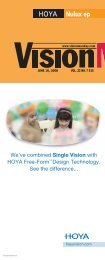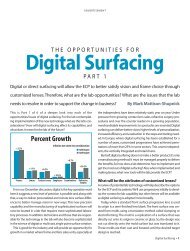The Opportunities For Digital Surfacing - Part 3
The Opportunities For Digital Surfacing - Part 3
The Opportunities For Digital Surfacing - Part 3
You also want an ePaper? Increase the reach of your titles
YUMPU automatically turns print PDFs into web optimized ePapers that Google loves.
Let me quote Pierre Fay, executive vice president of Luxottica, regarding<br />
digital surfacing. He says,“In the very near future, lenses will adapt to<br />
the consumer rather than the consumer having to adapt to their lenses.”<br />
What does this mean in terms of <strong>Digital</strong> <strong>Surfacing</strong>? <strong>Digital</strong> surfacing provides<br />
the mechanism to deliver truly personalized lenses i.e.,lenses adapted<br />
for the patient’s vision and lifestyle requirements.It also meets our industry’s<br />
need for constant improvement to the way we make people see with the<br />
eyewear delivered.It increases patient satisfaction and improves business.<br />
How Will <strong>Digital</strong> <strong>Surfacing</strong> Improve Lenses?<br />
Naively, one would expect that for any variety of patients’ prescriptions,<br />
especially when they are similar, a particular progressive would deliver the<br />
same quality of vision to each patient,i.e.,the same useful performance for<br />
distance, intermediate and near with the same peripheral effects. Not so.<br />
Patients see the results of their prescriptions combined with the effects of<br />
the lens design periphery.Depending on their own needs and sensitivities,<br />
they see differences or prefer one progressive to another. <strong>Digital</strong> surfacing<br />
can reduce those differences and improve the visual experience to make<br />
more patients happier the first time.<br />
We all have experienced the<br />
patient that tells us they see differently<br />
out of the temporal side of one<br />
of their lenses. <strong>The</strong> very fact that the<br />
lower periphery of a progressive surface<br />
gets steeper faster vertically<br />
than horizontally means there will be<br />
cylinder created. When combined<br />
with the patient’s prescribed cylinder,<br />
the resulting cylinder may affect<br />
peripheral vision right or left.<br />
This effect can be illustrated using a<br />
map of RMS (root mean square) power errors. RMS is a common mathematical<br />
method of combining a number of factors into one value,here the<br />
spherical and astigmatic power errors in a progressive to create a single<br />
blur value tha can be mapped. <strong>For</strong> distance vision, the error that creates a<br />
“noticeable border”is about 0.25D, for near the value is higher. In progressives,<br />
clear functional zones usually have less than 0.5 to 0.75D of blur<br />
depending on task and sensitivity.<br />
Here, three differrent -3.00 prescriptions deliver slight differences. In<br />
these three examples, the same base curve lens ‘sees’ a little differently<br />
depending on Rx and patient perception.<br />
2• <strong>Digital</strong> <strong>Surfacing</strong><br />
RMS power error map, modern<br />
Plano distance power lens.<br />
-3.00 Sph -3.00 -1.50 x 180 -3.00 -1.50 x 45<br />
ADVERTISEMENT<br />
Here’s the same comparison for +3.00 powers.<br />
+3.00 Sph +3.00 -1.50 x 180 +3.00 -1.50 x 45<br />
<strong>The</strong> point here is to recognize that when using the same base curve for<br />
different patients,especially for those prescriptions at the edges of the prescription<br />
range, they don’t get the best vision possible.<strong>The</strong> same is true<br />
when the recommended base curve for each eye’s Rx is different. In this<br />
case, the lab will usually use the flatter base curve for both eyes in favor of<br />
cosmetics.<strong>The</strong>refore,digital surfacing can be used to fix these differences.<br />
<strong>The</strong> most flexibility to improve designs is when both surfaces can be<br />
modified through digital surfacing either where the front is created from<br />
a digitally surfaced mold and the back helps modify remaining unwanted<br />
results or when the characteristics needed for the patient will be delivered<br />
using the best combination of front and back design.<strong>The</strong>y could be<br />
a combination of progressive, toric, spherical and aspheric or atoric.<br />
<strong>For</strong> Example<br />
Let’s look at an example of a targeted design, the way it would deliver its<br />
prescription after surfacing and how a lab with digital surfacing ability<br />
could optimize that same prescription.<br />
<strong>The</strong>se following ray-traced optical astigmatism plots illustrate the point.<br />
<strong>The</strong> first illustration represents the “Intended Design for Plano +200 Add.”This<br />
is the design that we would expect for all patients using that base curve.<br />
However, when we use this lens blank for an Rx at the edge of the<br />
prescription range for that base curve, +2.00 -1.50 x 045 (with 2 deg<br />
pantoscopic tilt and a slight 5 deg face form), the distribution of astigmatism<br />
delivered is different. <strong>The</strong>re is an increase in astigmatism and<br />
the usability of the viewing zones is changed.<br />
Intended design SF Blank Surfaced<br />
to +2.00 -1.50 x 045<br />
Optimized through<br />
digital surfacing<br />
<strong>The</strong> third illustration or "Optimized Lens" file has been optimized<br />
for the Rx +2.00 -1.50 x 045 (with 2 deg of pantoscopic tilt and 5 deg<br />
of face form) and while this is actually a simulated example, the actual<br />
example is very close. Remember from <strong>Part</strong> 2 of this series, digital<br />
surfacing allows an exact surface replication of the design required. A<br />
lens can therefore be optimized to deliver better vision, and for some<br />
patients, a wow.
















